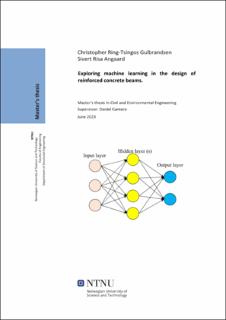| dc.description.abstract | I den digitale transformasjonens æra, har maskinlæring, et lovende underområde av kunstig intelligens, funnet veien inn i diverse fagfelt, inkludert bygg- og konstruksjonsteknikk. Denne masteroppgaven utforsker bruken og sammenligningen av maskinlæringsmodeller i dimensjonering av slakkarmerte betongbjelker, med fokus på tre distinkte, men sammenkoblede oppgaver: predikering av forventet kapasitetsoverskridelse (Oppgave 1), predikering av kapasiteter (Oppgave 2), og kostnadsoptimalisering av T-tverrsnitt (Oppgave 3). Oppgavene
fungerer som inngangsporter for å forstå klassifisering, regresjon og optimaliseringsteknikker innen maskinlæring. Oppgave 1 benytter seg av maskinlæringsklassifiseringsteknikker for å gi en grundig undersøkelse av multiklasse-klassifiseringsmodeller. Disse modellene blir brukt for å vurdere strukturell integritet og sikkerhet. Oppgave 2 fokuserer på regresjonsmodeller, og utforsker tilhørende maskinlæringsteknikker for å estimere kapasitet i armerte betongbjelker. Oppgaven illustrerer potensialet disse modellene har til å forsterke konvensjonelle metoder for estimering av kapasitet. Oppgave 3 bruker en multivariat regresjonsmodell trent på et optimalisert datasett for å predikere kostnadseffektive design. Dette understreker maskinlæringens potensial i strukturell designoptimalisering. For å utføre oppgavene, ble datasett generert ved å digitalisere dimensjoneringsregler fra den Europeiske Standarden EN 1992-1-1 (EC2).
MLP modellen viste gode resultater i oppgavene 1 og 3, og i oppgave 2 ble SVR den best presterende modellen. Til tross for lovende resultater i alle oppgaver, ble resultatene noe påvirket av datakarakteristikker som klasseubalanse, multikollinearitet, heteroskedastisitet og avvikende observasjoner, som påvirket modellenes ytelse. Til tross for at vi med sikkerhet kan identifisere modellene som var best egnet for de ulike oppgavene, bør fremtidig arbeid fokusere på å forbedre dem over tid. Dette kan innebære en dypere undersøkelse av de identifiserte utfordringene, samt trening på ny, usett eksperimentell data. Slike tiltak vil forbedre bruken av disse modellene som praktiske verktøy for fagfeltet bygg- og konstruksjonsteknikk. Gjennom detaljert litteraturgjennomgang og praktisk anvendelse av maskinlæringsalgoritmer, gir denne masteroppgaven et betydelig grunnlag for fremtidig utforskning i skjæringspunktet mellom maskinlæring og konstruksjonsteknikk. Videre fremmer den en datadrevet tilnærming til forståelse og design av strukturelle systemer. Til slutt oppfordrer den til ytterligere integrasjon av maskinlæring i både praksis og utdanning innen konstruksjonsteknikk, samt understreker den viktige rollen maskinlæring vil få i å løse komplekse oppgaver i bransjen. | |
| dc.description.abstract | In the era of digital transformation, Machine Learning (ML), a vital subset of Artificial Intelligence (AI), has found its way into a variety of fields, including structural engineering. This master's thesis explores the application and comparison of ML models in the design of reinforced concrete (RC) beams, with a focus on three distinct, yet interconnected tasks: predicting the anticipated capacity failure mode (Task 1), predicting capacities (Task 2), and cost optimization of T-section design (Task 3). These tasks serve as gateways to understanding classification, regression, and optimization techniques in ML, respectively.Task 1 leverages ML classification techniques, providing an in-depth exploration of multiclass classification models in assessing structural integrity and safety. Task 2 delves into regression models, employing ML regression techniques for accurate structural capacity estimation in RC beams, demonstrating the potential of these models in augmenting conventional capacity prediction procedures. Task 3 employs a multivariate regression model trained on an optimized dataset for predicting cost-effective designs, underscoring the potential of ML in optimizing structural design. To execute these tasks, datasets were generated by digitally encoding design
rules from the European Standard EN 1992-1-1 (EC2). MLP demonstrated good results in tasks 1 and 3, while SVR stood out as the overall top performer in Task 2. Despite these promising findings across all tasks, the results were somewhat affected by data characteristics, such as class imbalance, multicollinearity, heteroscedasticity, and outliers, all of which impact the performance of ML models. Although we can confidently conclude on the best-fitting models for the tasks, future work should focus on improving these models over time. This could involve delving deeper into the challenges that we have identified, as well as
incorporating new, unseen experimental data. Such efforts will enhance the utility of these ML models as practical tools for structural engineers.This master's thesis, through a detailed literature review, the provision of comprehensive documentation including scripts related to the models and dataset generation, as well as the
practical application of ML algorithms, provides a significant foundation for future exploration in the intersection of ML and structural engineering. It promotes a data-driven approach to understanding and designing structural systems and ensures that others can replicate and build upon our study. Lastly, it encourages the integration of ML in structural engineering practices and education, while highlighting the role of ML in addressing complex structural design tasks. | |
